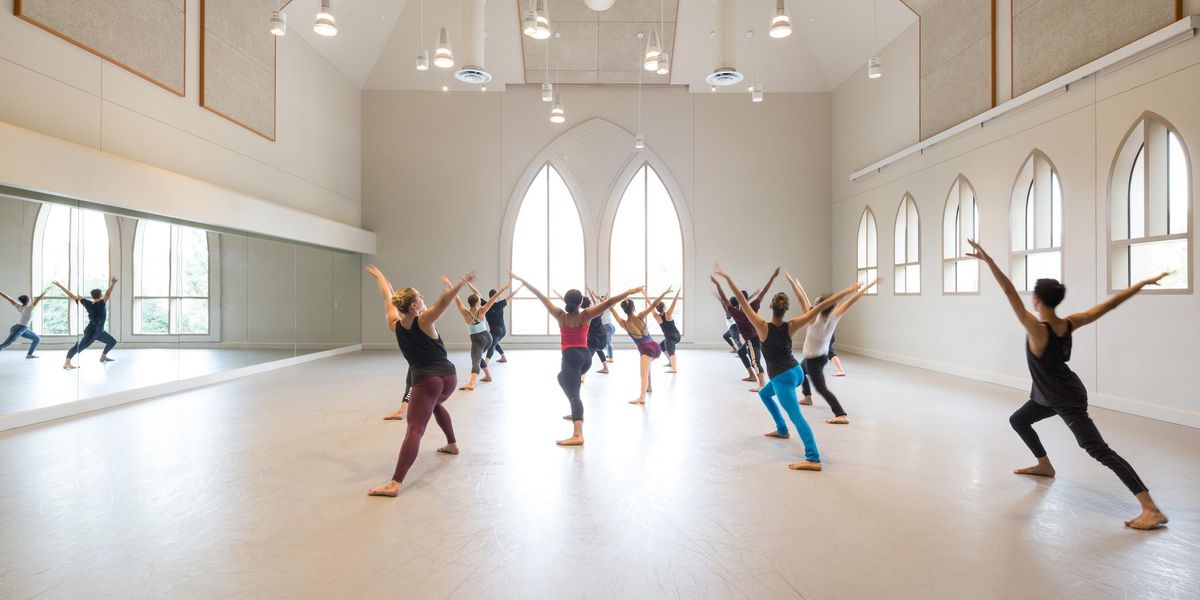Why Is Crystal Pite’s Darkness Uplifting Rather Than Depressing?
There is something wonderfully creepy about Crystal Pite’s work. Sometimes a light boom moves in the dark, as though the light itself is stalking the dancers. The interactions between people can be dangerous: Kindness one second, violence the next. But they are never less than fascinating.
Her collection of four pieces, titled The You Show, hints at various personal crises. In the first, “A Picture of You Falling,” a man and woman seem to keep missing each other, like ships passing in the night. One lurks in shadows as the other dances. Anne Plamondon, guesting with the company, is sharp and intense. She takes a single move to extremes, so a simple arm reach behind her turns into a crazy finger-spreading pull that torques her body out of shape.
Anne Plamondon and Peter Chu in “A Picture of You Falling.” Photo by Julieta Cervantes, Courtesy BAC.
Peter Chu moves with stealth as though he’s trying to hide. His very presence is existentially gripping. He turns doubt into something momentous. He moves big, like a dinosaur fighting extinction—but a video-game dinosaur.
The dancers are not pulled up; they’re even a bit slouchy, with dislocations à la voguing. They do not smile. (What a relief!) It’s like they’ve fallen into an abyss edged with fear. Within this void you notice the incredibly complex choreography. It’s as if each action of the body were a different texture: maybe an arm is silk, the chest is burlap, and the lower back is rubber.
Even with all those textures intercepting each other, the dance often syncs up with the music. When Chu falls to the floor, a thud or a crash accents the catastrophic. Or you hear a recorded voice say his heart is falling to the floor as his hand slowly sways back and forth to the floor. The heart can plummet or the heart can drift.
Finally Chu and Plamondon get together. At the end of this duet, Chu holds Plamondon but she keeps slithering down away from him. His face is stoic, a stony veneer hiding what’s underneath, as he finally loses her completely. A Romeo for the abyss.
I’m not sure the taped voice helped. The text, written by Pite, has lines like, “You remember the wind and the taste of salt. It was later that same day that it happened.” A bit cryptic, a bit Kafkaesque. I liked watching how Pite treads almost too close to merely illustrating the text.
The second piece, a duet with alter ego for Eric Beaucesne and Jirí Pokorny, is even more Kafkaesque. “The Other You” involves a strange mirror sequence (the two dancers, both bald, look very similar) and some expert remote puppetry. It’s psychologically confounding—Who is controlling whom? Maybe this is a single character from Dostoyevsky’s Notes from the Underground wrestling with his demons. The style occasionally dips into vaudeville, showing the humorous lining of this tortured pairing.
(I’m skipping the third duet because it didn’t add much except for a striking score that sounded like shattering glass. But I want to say that all the way through, Owen Belton’s original music was a major element in creating this special dark place of Pite’s.)
The last segment, “A Picture of You Flying,” amplifies those moments of humor. It capitalizes on Jermaine Maurice Spivey’s phenomenal dancing and charming modesty in speaking. His monologues identifies him as a reluctant superhero who’s having problems with his girlfriend. The relationship impasse becomes epic in a hilarious battle between Spivey and Sandra Marín Garcia as martial arts superheroes, each aided by several robot assistants.
Jermaine Maurice Spivey in “A Picture of You Flying.” Photo by Julieta Cervantes, Courtesy BAC.
Sometimes I think that Pite’s brand of virtuosity—the sharply changing textures, the incredibly intricate timing between partners, the control of the hip-hop influenced, mercurial flow—is not as perceptible to critics as leaps and pirouettes. But for me, I can’t get enough of her stage ideas and her dancers. I am transported to a dark place laced with wit and humor. And maybe it’s a place I’m already familiar with but don’t like to visit unless I’m sitting safely in a theater.




